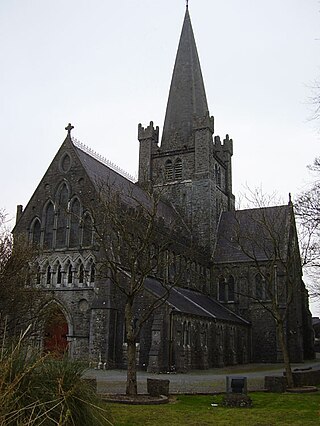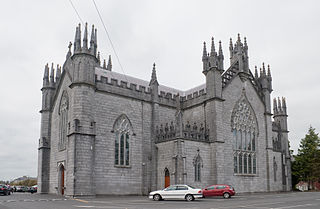
The Archbishop of Tuam is an archbishop which takes its name after the town of Tuam in County Galway, Ireland. The title was used by the Church of Ireland until 1839, and is still in use by the Catholic Church.

John MacHale was the Irish Roman Catholic Archbishop of Tuam, and Irish nationalist.

The Diocese of Killala is a Latin Church diocese of the Catholic Church in Connacht; the western province of Ireland. It is in the Metropolitan Province of Tuam and is subject to the Metropolitan Archdiocese of Tuam. As of 2024, the seat of the Diocese is “Sede Vacante” meaning there is no current permanent Bishop appointed for this Diocese
The Bishop of Kilfenora was a distinct episcopal title which took its name from the village of Kilfenora in County Clare in the Republic of Ireland. In both the Church of Ireland and the Roman Catholic Church, the title is now united with other bishoprics.

Flaithrí Ó Maolchonaire, was an Irish Franciscan and theologian, founder of the College of St Anthony of Padua, Leuven, and Archbishop of Tuam.
John McEvilly (1818–1902) was an Irish Roman Catholic Church clergyman who served as the Archbishop of Tuam from 1881 to 1902.
John de Burgh, or de Burgo, or Burke was an Irish Roman Catholic clergyman who served as Vicar Apostolic (1629–41) and Bishop of Clonfert (1642–47), and Archbishop of Tuam (1647–67).

Oliver Kelly or O'Kelly (1777–1834) was an Irish clergyman of the Roman Catholic Church who served as the Archbishop of Tuam from 1815 to 1834.
Joseph Walsh (1888–1972) was an Irish clergyman of the Roman Catholic Church. He served as Archbishop of Tuam from 1940 to 1969.

Thomas Patrick Gilmartin was an Irish clergyman of the Roman Catholic Church. He served as Bishop of Clonfert from 1909 to 1918 and Archbishop of Tuam from 1918 to 1939.
The Most Rev. Dr John Healy (1841–1918) was an Irish clergyman of the Catholic Church. He served as Lord Bishop of Clonfert from 1896 to 1903 and as Lord Archbishop of Tuam from 1903 to 1918.
Philip Phillips was an Irish clergyman of the Roman Catholic Church. He served as Archbishop of Tuam from 1785 to 1787.
Michael Skerrett was an Irish clergyman of the Roman Catholic Church. He served as Archbishop of Tuam from 1749 to 1785.
Maol Muire Ó hÚigínn, also Maol Muire Ó Huiginn, was an Irish Catholic clergyman. A Franciscan, he was appointed Archbishop of Tuam by the Holy See on 24 March 1586, and died in office.
James Lynch was an Irish Roman Catholic clergyman who served as Archbishop of Tuam from 1669 to 1713.
Francis Burke, or de Burgo, or de Burgh was an Irish Roman Catholic clergyman who served as Archbishop of Tuam (1713–1723).
William Mullally, whose family name also appears as Ó Mullally, O'Mullally, Lally, Laly or Lawly, was Archbishop of Tuam in the Church of Ireland from 1573 to his death in 1595.
Thomas Walsh born in Waterford, Ireland in 1580 - died in Santiago de Compostela, Spain in 1654; was an Irish prelate of the Roman Catholic Church. He served as the Archbishop of Cashel from 1626 to 1654.
Bernard O'Gara was an Irish clergyman who served as the Roman Catholic Archbishop of Tuam from 1723 to 1740. O'Gara was the grandson of Fearghal Ó Gadhra.
Michael O'Gara was an Irish clergyman who served as the Roman Catholic Archbishop of Tuam from 1740 to 1748.






